May 3 - 9, 2015: Issue 212
The First Royal Visitor to Australia: the Incident at Clontarf
March 12th, 1868
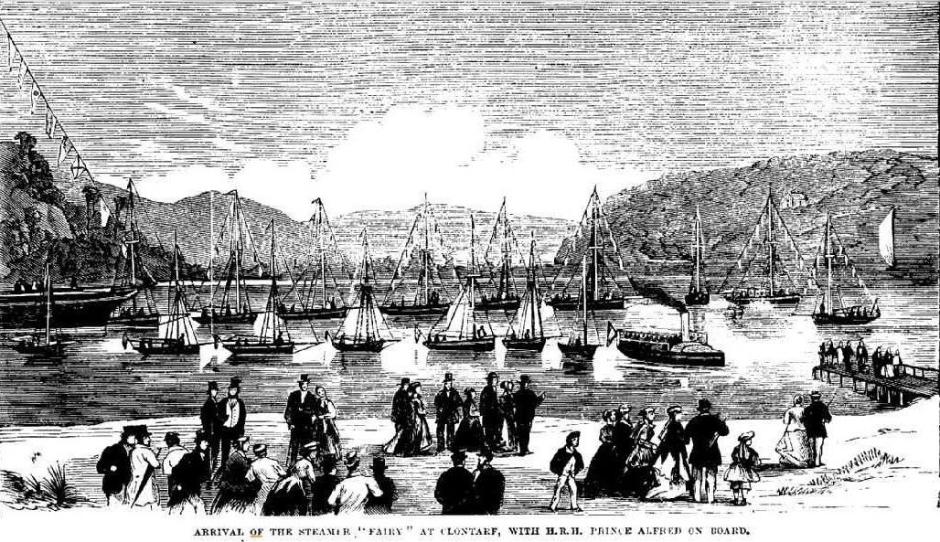
ARRIVAL OF THE STEAMER "FAIRY" AT CLONTARF, WITH H.R.H. PRINCE ALFRED ON BOARD. THE RECENT ATTEMPT ON THE LIFE OF His Royal Highness THE DUKE OF EDINBURGH. (1868, April 20). Illustrated Sydney News (NSW : 1853 - 1872), p. 1 Supplement: SUPPLEMENT TO THE ILLUSTRATED SYDNEY NEWS. Retrieved from http://nla.gov.au/nla.news-article63513927
The First Royal Visitor to Australia: the Incident at Clontarf
March 12th, 1868
Pittwater has many connections with the British Royal Family; the Royal Prince Alfred Yacht Club was named for the first member of the Royal family to visit Australia, Prince Alfred, when the club members still sailed on Sydney Harbour and to Pittwater. His ‘picnic’ at Clontarf to support the Sailors Home, an assassination attempt by a very recent arrival, and the outrage of citizens afterwards, begins a long and enduring romance with and for succeeding generations of our Royal family.
The second Royal visitors to our shores, Princes Albert and George, came here too in 1883 for a visit, boarding a steamer at Newport Wharf for a tour along the Hawkesbury River. They travelled overland in a coach they boarded at Manly – their relative’s experience not deterring a chance to see the beauty of this place.
In 1901 the Duke and Duchess of Cornwall and York also spent a restful time on the Hawkesbury, mooring adjacent to our estuary in Cowan Creek, after their official duties in opening the first Parliament of Australia in the year of our Federation.
Some residents recall being a part of Queen Elizabeth’s first visit as Naval Cadets, while Palm Beach SLSC founding member and ‘the Father of Surf Life Saving’, Adrian Curlewis, along with his wife Betty Curlewis, were gracious hosts of Queen Elizabeth II and the Duke of Edinburgh at the Bondi Royal Surf Carnival of 1954. Many still remember Her Majesty’s later visit to Manly, to the Royal Far West Children’s home in 1970 or her mother's salute of a 1958 Life Saving Carnival for her benefit at Manly too.
During the 1954 Royal Tour Her Majesty’s ladies-in-waiting caused some to think the Queen was water skiing on Narrabeen Lagoon or lunching at Palm Beach until who was whom was clarified. Some are still certain Queen Elizabeth did have a few days off at Palm Beach which reports from that year can neither confirm nor deny:
Ladies-in-waiting Confuse Crowds
Cars containing the Queen's Ladies in-Waiting confused crowds yesterday who rushed to see the Queen pass. The people thought the Queen would be in the cars. The Ladies-in-Waiting are Lady Pamela Mountbatten and Lady Alice Egerton. Both went driving-Lady Pamela to Narrabeen Lake to water-ski, and Lady Alice to Palm Beach.
Hundreds thought Lady Pamela was the. Queen when they saw her driving to Narrabeen Lake. She drove to the lake in a Royal tour Daimler. Two men went with her to the lake, and also Miss Elizabeth Northcott, daughter of the Governor of N.S.W., Sir John Northcott.
ARMY DRIVERS
The party used two cars driven by Army personnel. Crowds rushed to the road-side, waving flags and cheering when they saw the two cars approaching. Both cars were black and both bore silver crowns. About 150 people were waiting outside Dalwood Homes, in Wakehurst Park-way in case the Queen passed. They groaned with disappointment when they saw that neither the Queen nor the Duke of Edinburgh was in the cars.
Groups of people further along the road caught only a glimpse of the occupants, and thought they had seen the Queen. When told they had not seen the Queen they decided to wait in case she also passed. Mr. W. Ledsan, president of the Dolphin Water Ski Club, met the party at the lake.
Lady Mountbatten then changed from a light cotton print frock into a white swimming costume and she and Miss Northcott climbed into a motor boat. Mr. Ledsan drove the motorboat to the end of the lake, where the water was calm. Half an hour later the boat returned towing Lady Pamela on water-skis.
Water-ski experts, among a crowd of 200 who watched, said Lady Pamela was a proficient water-skier. She was on the lake for nearly an hour.
PALM BEACH TRIP
Lady Alice Egerton, meanwhile, was in a party of two Royal cars that went to Palm Beach. With her were the Queens secretary, Sir Michael Ademe, her assistant secretary, Colonel Martin Charteris, the Minister in charge of the Royal tour, Mr. Eric Harrison, and the Commonwealth Director, Lieutenant-Colonel F. H. Berryman.
Crowds cheered, waved, and tooted motor horns as the cars passed them on the way to Palm Beach. When they saw the Queen was not in the cars they also decided to wait for the Queen. A rumour spread that the Queen's car would come next.
At Palm Beach the party went to the home of Mr. Sam Walder. All the party surfed later except Lady Alice, who sat on the beach. Mr. Walder's home is near the home of Mr. J. Carroll, where it was rumoured last week that the Queen and Duke would rest. Ladies-in-waiting Confuse Crowds. (1954, February 8). The Sydney Morning Herald (NSW : 1842 - 1954), p. 4. Retrieved from http://nla.gov.au/nla.news-article18408639
Other officials attending the Royal Family have also taken part in Pittwater times either informally or formally – a lovely example resounds from October 5th 1958, when Admiral H.J. Buchanan, C.B.E./D.S.O., aide-de-camp to both King George VI and Queen Elizabeth II, officially opened the Avalon Sailing Club.
Brian Friend OAM, related being privileged in his days as a member of the Water Police of Pittwater to be part of the crew that gained a day off for, and a visit to where so many relatives had been before them, in showing Prince Charles and Lady Diana around our superlative estuary and her waters.
More recently Prince Harry was part of the International Fleet Review salute at Bradley’s Head, within cooee of the Northern Beaches, while Prince William and Duchess of Cambridge, Kate, made sure Manly and a Surf Life Saving Carnival was part of their first tour here together.
Many Royal family members have served as members of the Royal Navy, and all arrive in Sydney Harbour on ships, so visiting Pittwater or other places on the Northern Beaches would allow them an insight or a day off in an environment they love as well as getting to experience eponymous Australian events and lifestyle. The affection remains mutual in a place that welcomes all and celebrates what is known locally as ‘democracy on the sand and water’.
An article we ran a few weeks back on Jane Connor's new book, Royal Visits to Australia, inspired us to look closer at the incident Jane nominated as one that most intrigued her, the 'assassination attempt' on Australia's first Royal visitor, a then 23 year old HRH The Prince Alfred, Duke of Edinburgh, the second son and fourth child of Queen Victoria, who visited Clontarf on March 12th, 1868 to attend a Sailor's Home picnic and was shot by a man who, from this distance, clearly sounds as though he was suffering from some kind of psychological condition:
ATTEMPT TO ASSASSINATE H. R. H. PRINCE ALFRED, AT CLONTARF.
IT is with the deepest sorrow that we have to announce a most determined attempt to assassinate his Royal Highness the Duke of Edinburgh. When the Prince left the luncheon tent at the Sailors' Home Picnic (a report of which will be found in another column), he escorted the Countess of Belmore to the door of the Royal tent, and then turned to converse with his Excellency the Governor, the Chief Justice, and Sir William Manning. They remained talking a few seconds, and then his Royal Highness and Sir William Manning sauntered across the green towards the clump of trees bordering the beach, and under which the Galatea Band was stationed.
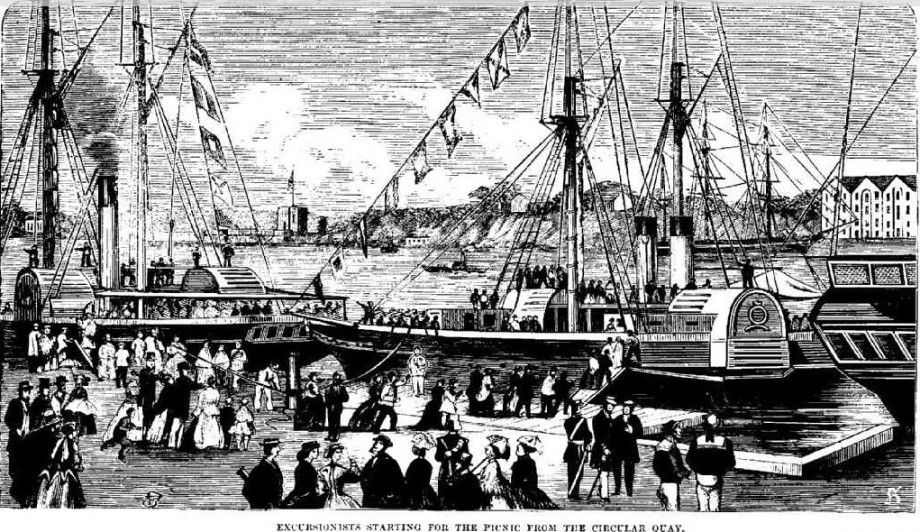
EXCURSIONISTS STARTING FOR THE PICNIC FROM THE CIRCULAR QUAY. THE RECENT ATTEMPT ON THE LIFE OF His Royal Highness THE DUKE OF EDINBURGH. (1868, April 20). Illustrated Sydney News (NSW : 1853 - 1872), p. 1 Supplement: SUPPLEMENT TO THE ILLUSTRATED SYDNEY NEWS. Retrieved fromhttp://nla.gov.au/nla.news-article63513927
The subject of conversation was the Sailors' Home, and his Royal Highness, to mark his appreciation of the institution, handed Sir William a cheque as a donation to the institution. Sir William made his acknowledgments for the donation, and then asked his Royal Highness whether he would go round to Cabbage Tree Beach to see the aboriginals, as they were then ready for some sports.
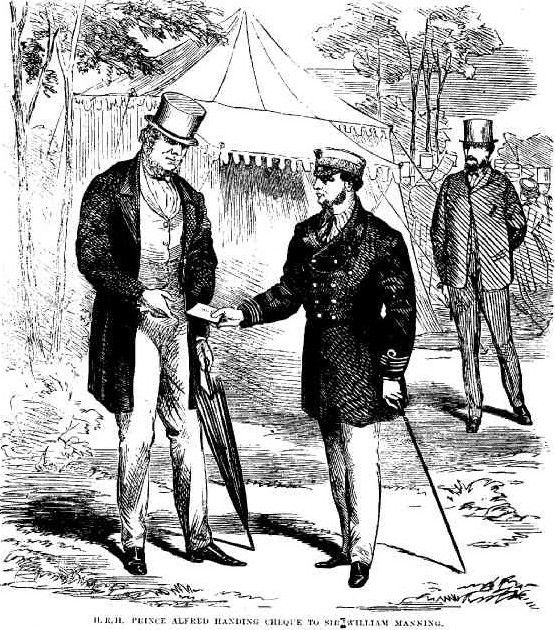
H.R.H. PRINCE ALFRED HANDING CHEQUE TO SIR WILLIAM MANNING. THE RECENT ATTEMPT ON THE LIFE OF His Royal Highness THE DUKE OF EDINBURGH. (1868, April 20). Illustrated Sydney News (NSW : 1853 - 1872), p. 1 Supplement: SUPPLEMENT TO THE ILLUSTRATED SYDNEY NEWS. Retrieved from http://nla.gov.au/nla.news-article63513927
Before his Royal Highness could reply a treacherous assailant, who had just left the crowd of persons congregated under the shade of the trees, stole up behind him and when he had approached to within five or six feet pulled out a revolver, took deliberate aim, and fired. The shot took effect about the middle of the back of his Royal Highness, an inch or two to the right of the spine. He fell forward on his hands and knees, exclaiming," Good God, my back is broken."
Sir William Manning, hearing the discharge, and seeing his Royal Highness fall, turned and sprang at the would-be assassin, who then jumped back and aimed the murderous weapon at Sir William. Seeing the pistol directed towards him, Sir William stooped to evade the shot, and, losing his balance, fell. Fortunately the charge did not explode; but as Sir William Manning was an the act of rising, the ruffian took aim a third time; just at the moment Mr. Vial (of Castlereagh-street), who happened to be behind, sprang upon the dastardly assailant, pinioned his arms to his side, and thus the aim of the pistol was diverted from the body of Sir William Manning to the ground. The weapon was discharged, however, and the shot entered the foot of Mr. George Thorne, senior, who fainted, and was taken away by Mr. Hassall, and other friends.
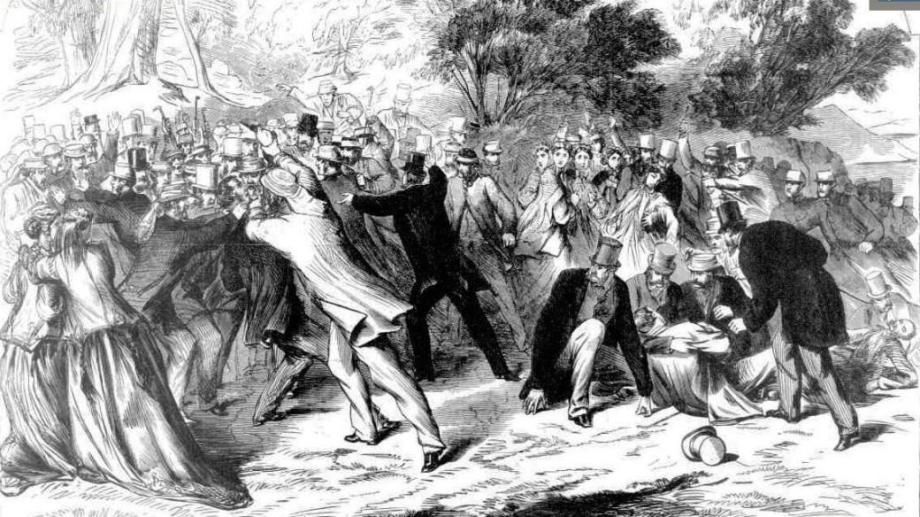
Picture: MR. THORNE IS ALSO SHOT. ATTEMPTED ASSASSINATION OF THE DUKE OF EDINBURGH. (1868, March 23). Illustrated Australian News for Home Readers (Melbourne, Vic. : 1867 - 1875), p. 8. Retrieved from http://nla.gov.au/nla.news-article60448809
In the meantime a number of people, attracted by the discharge of firearms, and seeing his Royal Highness fall, ran to the spot, and three or four of them, among whom was Mr. T. Hales and a young gentleman named M'Mahon, lifted his Royal Highness to carry him into his tent. It was evident from the demeanour of his Royal Highness that he was suffering great pain, and he asked his bearers to carry him gently. This wish was complied with as far as possible, and thus he was borne into his tent. Here he was taken in charge by Dr. Watson, of H. M. S. Challenger, who together with Dr. Wright (of Sydney), Dr. Powell of the Galatea, and Assistant-surgeon Waugh of the Challenger, were immediately in attendance. The dress of his Royal Highness was removed, and upon an examination of the wound it was found that the bullet had penetrated the back, near the middle, and about two inches from the right side of the lower part of the spine, traversing the course of the ribs, round by the right to the abdomen, where it lodged, immediately below the surface. No vital organ, fortunately, appeared to be injured, the course of the bullet being, to all appearance, quite superficial.
While this painful examination was in progress another scene, which almost defies description, was going on in another part of the ground. No sooner had Mr. Vial grasped the arms of the man who had fired the shots, than Mr. Benjamin Mortimer (an American gentleman), Mr. Whiting (of the firm of Drynan and Whiting), A. L. Jackson, and other gentlemen seized him; and, had it not been for the closing in around them of the police and other persons, they would speedily have placed him beyond the reach of the Law Courts.
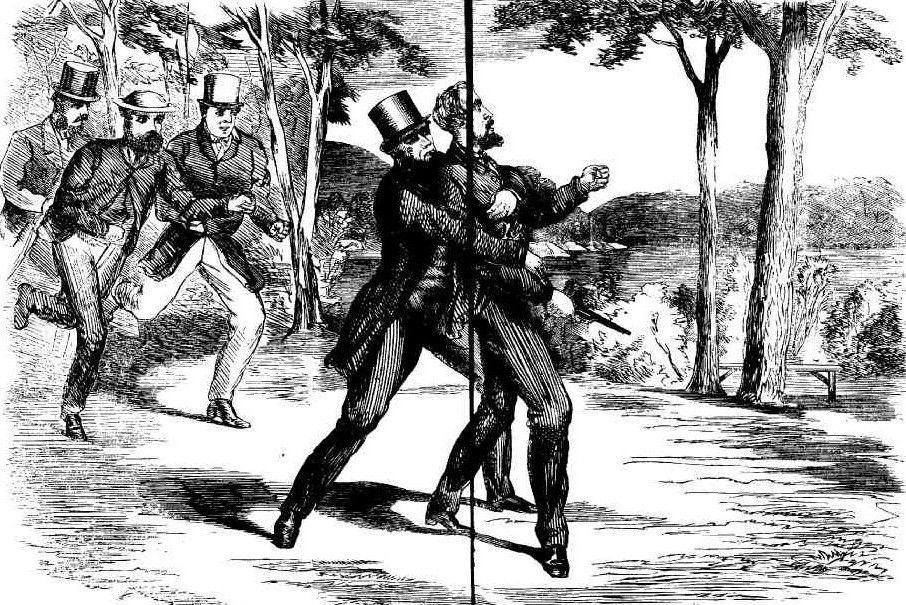
MR. VIAL SEIZING THE ASSASSIN. THE RECENT ATTEMPT ON THE LIFE OF His Royal Highness THE DUKE OF EDINBURGH. (1868, April 20). Illustrated Sydney News (NSW : 1853 - 1872), p. 1 Supplement: SUPPLEMENT TO THE ILLUSTRATED SYDNEY NEWS. Retrieved from http://nla.gov.au/nla.news-article63513927
The people shouted "lynch him," "hang him," "string him up," and so on, and there was a general rush to get at him. The police, headed by Superintendent Orridge, got hold of the assassin, and they had the greatest difficulty in preventing the infuriated people from tearing him limb from limb. In this the police were ably assisted by the Chief Justice, Lord Newry, and the men of the Galatea Band. Both Lord Newry and Sir Alfred Stephen exerted them-selves to get the prisoner on board the steamer lying at the wharf, while Mr. Orridge, with herculean strength, kept back the crowd as much as possible. The task of putting the prisoner on board the ship was not an easy one, and it was fully ten minutes before they could get him on to the wharf. By that time all the clothing from the upper part of his body was torn off, his eyes, face, and body were much bruised, and blood was flowing from various wounds; and when he was dragged on to the deck of the Paterson, he appeared to be utterly unconscious. No sooner was he onboard than a number of sailors had a rope ready to string him up, and it was only by the interference of Lord Newry that his life was spared. Some of the police were very roughly used, detective Powell getting about the worst of it. In the scuffle he fell over some stones, and had a chance of being trampled to death.
The whole of the police on the ground were under the command of Mr. Fosbery.
The people, out of whose hands the prisoner had been rescued, immediately gave vent to their disappointment, and, at an indignation meeting, summarily convened, determined to bring him back from the steamer, and dispatch him at the scene of his crime. A rush was then made for the steamer, which had just hauled off a few feet from the wharf, and they shouted to the captain to haul in. For a moment this officer appeared to waver, but the Hon. John Hay, who was on the bridge, doubtless divining the intentions of the crowd, peremptorily ordered the captain to haul off. This he did, and the vessel accordingly proceeded on her way to Sydney.
The effect of this dastardly attempt at assassinating the Prince, among the immense number of persons congregated at Clontarf, may be more easily imagined than described. A large number of ladies fainted, others were seized with hysterics, and the whole multitude was convulsed. Suddenly a joyous throng had been converted into a mass of excited people, in whose breasts sympathy for the Royal sufferer, and indignation for his murderous assailant, alternately prevailed; while pallid faces and tearful eyes told of the deep anxiety that was felt in reference to the extent of the injuries which his Royal Highness had sustained. People crowded by hundreds around the tent in which the sufferer lay, until they were informed that they must keep back, in order to allow free ventilation; they at once fell back thirty or forty yards and formed a complete cordon around the tent, and anxiously awaited the result of the examination. Finding the people so anxious about him his Royal Highness said "Tell the people I am not much hurt, I shall be better presently."
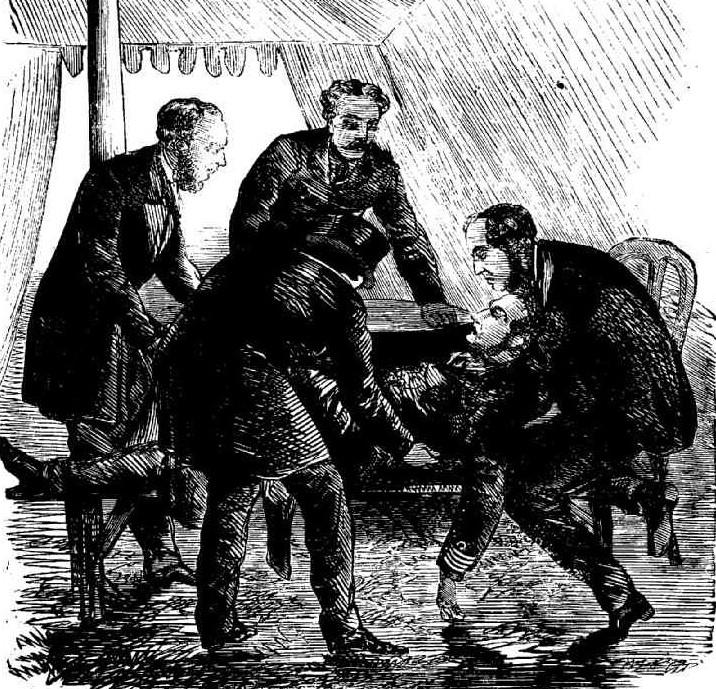
H.R.H. PRINCE ALFRED IN THE TENT AFTER THE ASSAULT. THE RECENT ATTEMPT ON THE LIFE OF His Royal Highness THE DUKE OF EDINBURGH. (1868, April 20). Illustrated Sydney News (NSW : 1853 - 1872), p. 1 Supplement: SUPPLEMENT TO THE ILLUSTRATED SYDNEY NEWS. Retrieved fromhttp://nla.gov.au/nla.news-article63513927
His Royal Highness, who never lost consciousness, although feeling faint and weak from the shock to his nervous system, and from loss of blood, described to his attendants the sensation he experienced when struck by the bullet. He said he felt as though he was being lifted off the ground.
At about five o'clock his Royal Highness was placed on a litter, and borne by men of the Galatea to the deck of the Morpeth, a solemn silence being preserved by the people, who stood on either side while the cortege passed. Among those who were in immediate attendance on his Royal Highness were the gentlemen of his suite, namely Lieutenant Haig, Lord Newry, and the Hon. Eliot Yorke, all of whom were painfully affected by the tragic occurrence. His Excellency the Governor, Commodore Lambert, Captain Beresford and Mr. Toulmin were also most assiduous in their sympathetic attentions, and proceeded to Sydney in the same boat. Prior to this the little steamer Fairy had been sent up to Sydney with a message for the officer in charge of the Galatea, to be prepared with a boat to convey the Royal sufferer to the shore; and when the Morpeth arrived off Farm Cove a barge from the Galatea came alongside. The Prince, who was lying upon a stretcher with a soft mattress under him, and his head supported by pillows, was lowered into his barge which was manned by a number of his own sailors. On arriving at the landing place he was carefully raised out of the boat. Rumours of the occurrence having reached town, large numbers of persons rushed to the jetty in front of Government House, where it was presumed the Prince would land. Here a body of police and marines were posted- some of them guarding the approach from the wharf to Government House, and others forming near the landing-place, in order to escort his Royal Highness. The crowd forced back to the high ground, and kept at some distance from the chosen line of route.
The Prince was surrounded by a guard of marines, and the sight of his prostrate and helpless condition called forth from the crowd many expressions of sympathy.
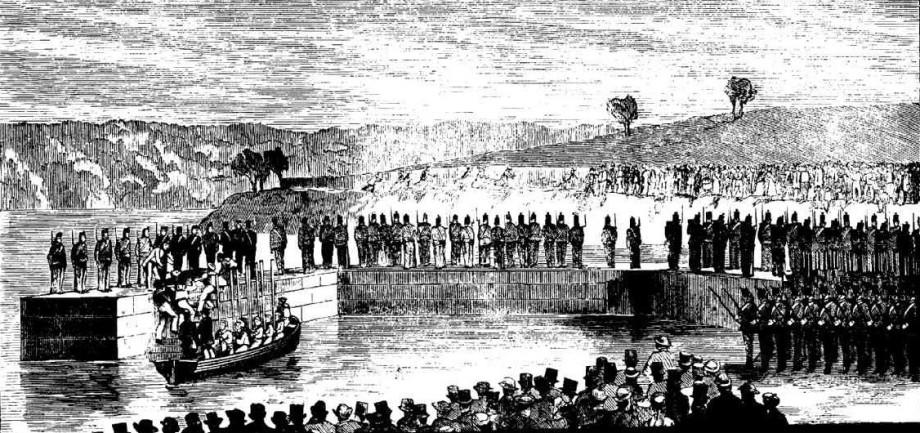
Picture: Landing the Prisoner. ATTEMPTED ASSASSINATION OF THE DUKE OF EDINBURGH. (1868, March 23). Illustrated Australian News for Home Readers(Melbourne, Vic. : 1867 - 1875), p. 8. Retrieved from http://nla.gov.au/nla.news-article60448809
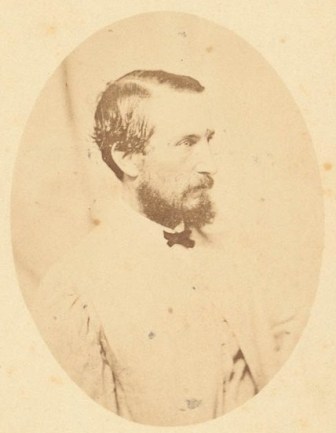 Upon the arrival of the Paterson at the wharf, the prisoner was landed and conveyed in charge of Mr. Orridge to the gaol. O'Farrell is a fair complexioned man, about five feet eleven inches in height, and apparently about five and thirty years of age. He has a slight beard and moustache, and a military air. He is perfectly self-possessed, is said to be a man of good education, and in manner is not unpleasing. He was dressed in a dark coat and trousers and white waistcoat.
Upon the arrival of the Paterson at the wharf, the prisoner was landed and conveyed in charge of Mr. Orridge to the gaol. O'Farrell is a fair complexioned man, about five feet eleven inches in height, and apparently about five and thirty years of age. He has a slight beard and moustache, and a military air. He is perfectly self-possessed, is said to be a man of good education, and in manner is not unpleasing. He was dressed in a dark coat and trousers and white waistcoat.
Right: Henry James O'Farrell, author of the assassination attempt on Alfred, Duke of Edinburgh, 1868 / photographer Montagu Scott, courtesy State Library of nSW, Image No.: a128287
His clothes were torn to ribbons by the excited crowd, and he received many severe bruises, his eyes being blackened, his nose swelled very much, and his lips puffed out like those of a negro. According to his own statements - although he says very little and maintains much reticence with respect to himself and the motives of his dastardly deed – he is a native of Dublin, but left Ireland at a very early age. He has been in many countries, has spent a considerable time on the European continent, and in America, and about three months ago came from Victoria to New South Wales.
He has expressed a hope that the Prince would not die, and says that he did not mean to kill, but merely to "frighten him " – a statement which is absurd upon the face of it. Two revolvers were found on him, one of which had not been discharged, and every chamber of which was loaded, - the other, the weapon, with which the attempt at assassination was committed, was picked up by one of the Galatea's bandsmen after the prisoner's capture. The latter is a small Colt's revolver, such as could easily be carried in the pocket.
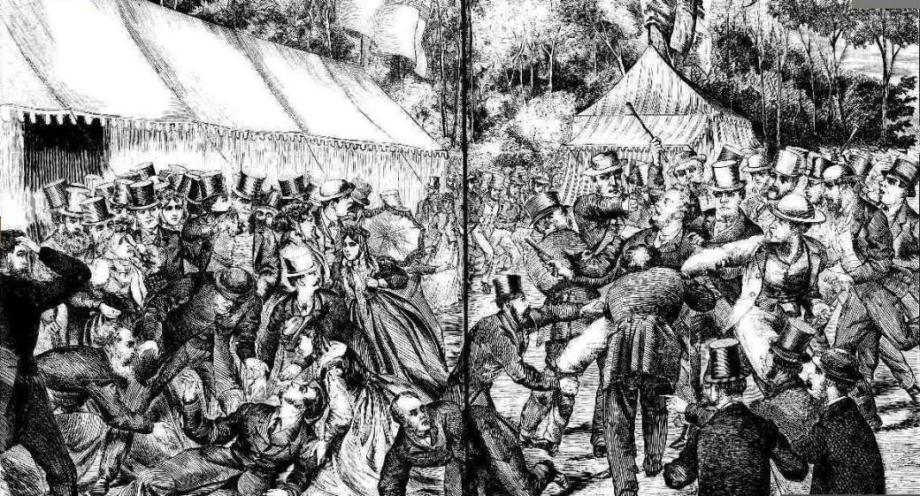
ATTEMPTED ASSASSINATION OF HIS ROYAL HIGHNESS DUKE OF EDINBURGH AT CLONTARF, MIDDLE HARBOUR. ATTEMPTED ASSASSINATION OF HIS ROYAL HIGHNESS DUKE OF EDINBURGH AT CLONTARF, MIDDLE HARBOUR. (1868, March 25). Illustrated Sydney News (NSW : 1853 - 1872), p. 8. Retrieved from http://nla.gov.au/nla.news-article63513891
Late in the afternoon a rumour was brought to the Legislative Assembly that the Prince was shot. The correctness of the information was doubted, and it was not until a reply to an inquiry was sent from the detective office, stating that a shot had been fired at the Prince, and that a person or persons were in custody, that the report was believed. Meantime Superintendent Orridge went up to the House, and reported that a man was in custody, and that he had conveyed him to the gaol. The House was at once adjourned. The Colonial Secretary, Mr. Parkes, proceeded to the gaol and saw the prisoner. He ascertained that his name was H. F. O'Farrell, that he slept on Wednesday night at the Clarendon Hotel, corner of George and Hunter streets.
The Colonial Secretary asked him how he came to commit such an outrage, to which he replied, "Come, come, it is not fair to ask me such a question as that the Prince is all right - the Prince will live, you need not fear about him - it's only a side wound - I shall be hanged but the Prince will live."
On leaving the gaol the Colonial Secretary taking with him two police constables went to the Clarendon Hotel. The people there knew nothing about the affair beyond hearing a rumour that the Prince had been shot. They admitted that such a man as the prisoner was described to be, had lived there, and the room in which he had slept was at once searched. Some articles of wearing apparel were found in a broken box and in a table drawer. In various places(in the drawer and in the pockets of his clothes) were found percussion caps, detonating cartridges, wadding for revolvers, a Douay Bible, and a number of religious books, in which his name was inscribed. Having secured these things, the Colonial Secretary ascertained that O'Farrell had been in Sydney from about Christmas last, and that whilst the Prince has been here whenever the other lodgers in the house spoke of him this man got out of temper, and denounced him. He went out on Tuesday evening to go to the ball; but, for some reason, did not get in, and came back. The Colonial Secretary also ascertained that he had lived at Tierney's Currency Lass Hotel, corner of Pitt and Hunter streets; and to that house they proceeded. Here, in a box, said to belong to O'Farrell, they found a number of articles of clothing and some written papers, from which it was shown that he had resided in Melbourne.
It is almost impossible to describe the sensation which the news of the outrage produced in the city. When first heard it was treated as a mere rumour; many persons saw the police take the prisoner from the Paterson, but considered him merely some fellow who had got his clothes torn in a drunken brawl. It was not until the announcement was made in the Assembly, and that the members on retiring mentioned the fact, that the news received any credence. The excitement was intensified by the appearance of a party of mounted police dashing at full speed towards the Circular Quay; a party of foot police, fully armed, followed and took up their positions opposite the landing-stage, where it was reported that the Prince would be landed. Several thousand citizens were assembled about the wharf and on board the vessels lying alongside, where they remained until information was received that the Prince had been taken to Government House.
The police then withdrew, and the people dispersed. A member of our staff, who had started from Clontarf for the city directly after the outrage was perpetrated, brought the particulars, which were immediately printed, and some thousands distributed, and eagerly read. The streets were thronged with people, whose sole topic appeared to be the sad event; it was evident that some gigantic calamity, affecting all classes of the people, had taken place, and spread sorrow throughout the entire community. At the Prince of Wales Theatre, where his Royal Highness had announced his intention of being present on the occasion of Mr. Hoskins' benefit, a notice was posted, that in consequence of the dastardly outrage on the person of H. R. H. the Duke of Edinburgh, the theatre was closed for the night. At the School of Arts Dr. Carr announced that in consequence of the calamity which had fallen upon the colony in the attempted assassination of the Duke of Edinburgh, it would be unseemly for any entertainment being given; the audience at once acquiesced. Up to midnight many persons we reassembled at the doors of our office, desirous of learning the latest news, and expressing their sympathy for the Royal sufferer. An immense crowd also assembled at the gates leading to Government House, and anxiously enquired of persons coming from that direction, how the Prince was progressing.
The Bishop of Sydney, together with the Ministers and other gentlemen, called at Government House yesterday evening, but could not see the Prince. Miss Osborne was in attendance, and one of the nursing sisters remained during the night. His Royal Highness could not lie down. There was no appearance of hemorrhage. The medical gentlemen speak favourably of the case, as the Prince has youth, health, and a good constitution in his favour. ATTEMPT TO ASSASSINATED H. R. H. PRINCE ALFRED, AT CLONTARF. (1868, March 13).The Sydney Morning Herald(NSW : 1842 - 1954), p. 5. Retrieved from http://nla.gov.au/nla.news-article13154858
There was fallout from this incidence. Despite the Prince's plea for clemency, O'Farrell was hung on April 21st 1868 in the Darlinghurst Goal, while his false claims that he was acting under orders from the Fenian Brotherhood caused an anti-Irish throughout the 'colony of Australia'. Just a few examples of this:
Saturday night. H..H. the Duke of Edinburgh is getting on favorably. Mr George Thome, who received the second shot in his foot, is suffering great pain. The ball has not yet been extracted. The committee of the ball and regatta, which are advertised for St. Patrick's Day, is in bad odor. An indignation meeting will be held in most of the provincial towns. Abhorrence of the cowardly deed is universal. 'The Sailors' Home committee, the Civil servants and a number of other public bodies have adopted addresses of sympathy with the Duke. SYDNEY. 15th March.
H. R. Highness is progressing most favorably. He passed a goodnight, and slept almost without intermission. Poor Mr Thorpe- continues to suffer great pain. His medical attendants have-not yet attempted to extract the ball. The St. Patrick's Day ball and regatta have been postponed indefinitely. The committee is in bad odor, in consequence of treasonable expressions which have been used at some of their meetings. It is reported that the Government intend to prosecute the proprietors of the Freeman's Journal for having published some seditious articles. Mr Sullivan, the editor of this paper, refused, on a public occasion a short time ago, to drink to the toast of the Queen's health, and he had to leave Sydney privately on Saturday, as a number of people had gone to the office of the paper to look for him, with a view to wreak summary vengeance upon him. All the churches in Sydney were crowded today, and prayers were offered for the speedy recovery of his Royal Highness., No doubt is entertained here that the assassination was originally intended to have been perpetrated in Victoria, and that most of O'Farrell's accomplices will be found there. The bullet which was taken from the Prince's body; was flattened at one end. The Duke sat up for two hours this afternoon. He is in but little pain, and his spirits are good.' He received several visitors. ' Sydney, 16th March.
During the night he had a refreshing sleep, and is now again progressing favorably. The Irishmen employed on the Western Railway works have been warned not to proceed to-morrow with the intended funeral procession in honor of the three Fenians executed in Manchester. Indignation meetings are being held in all parts of the colony. ATTEMPTED ASSASSINATION OF THE DUKE OF EDINBURGH. (1868, March 23). Illustrated Australian News for Home Readers (Melbourne, Vic. : 1867 - 1875), p. 8. Retrieved from http://nla.gov.au/nla.news-article60448809
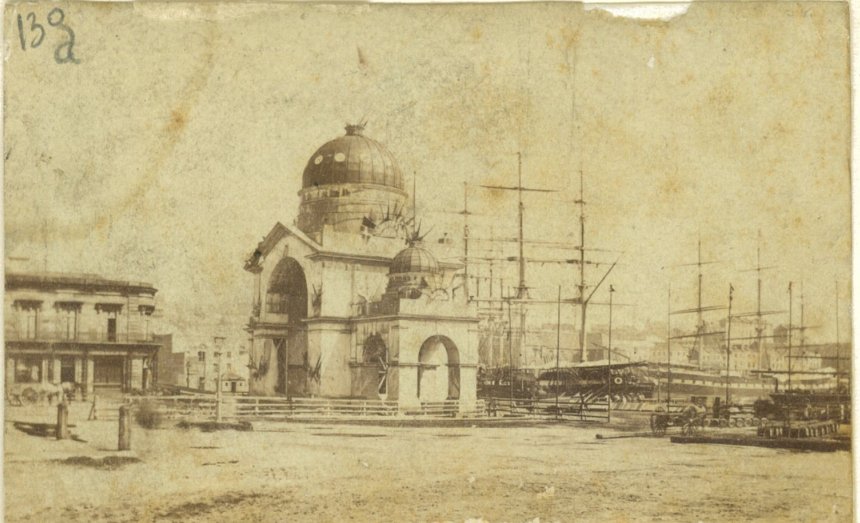
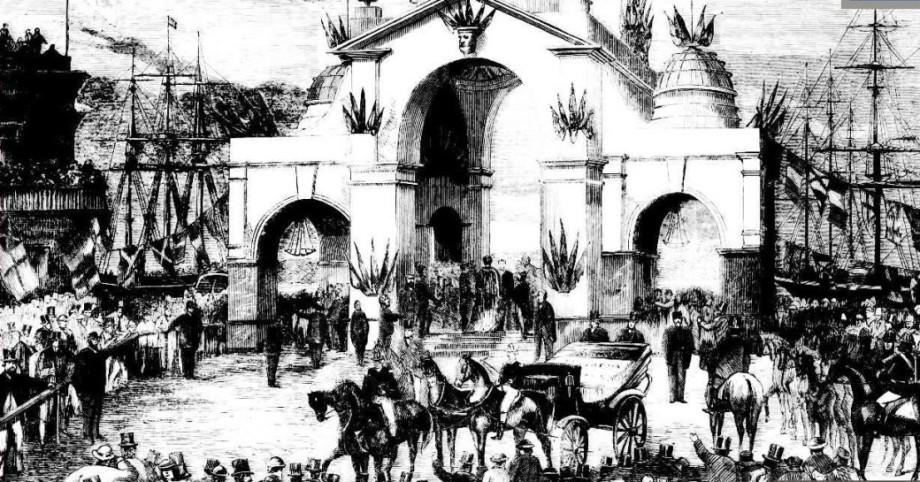
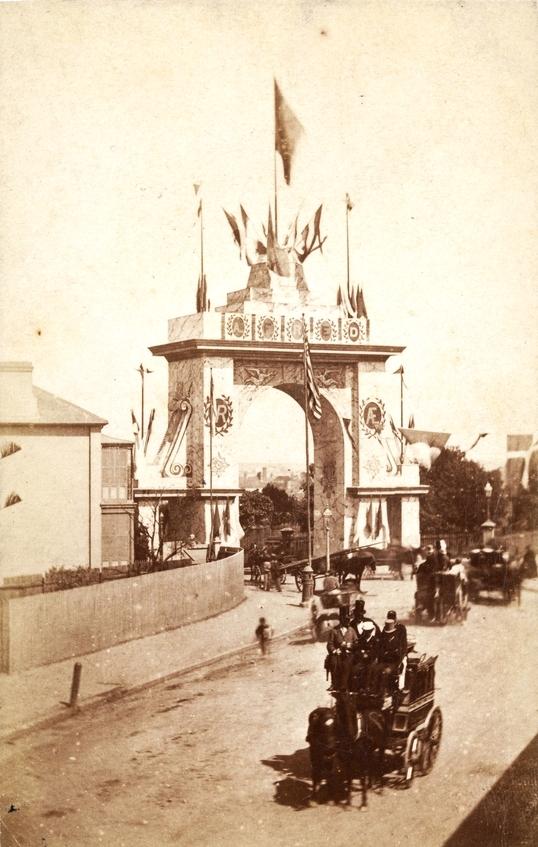 At the Colonial Secretary's Office, a transparency containing several well-executed figures, shewing that Art, Science, Charity, Justice, and Mercy, had their proper place in the Government of this colony. The figures were also intended to indicate the nature of the departments under the control of the Colonial Secretary. "
At the Colonial Secretary's Office, a transparency containing several well-executed figures, shewing that Art, Science, Charity, Justice, and Mercy, had their proper place in the Government of this colony. The figures were also intended to indicate the nature of the departments under the control of the Colonial Secretary. "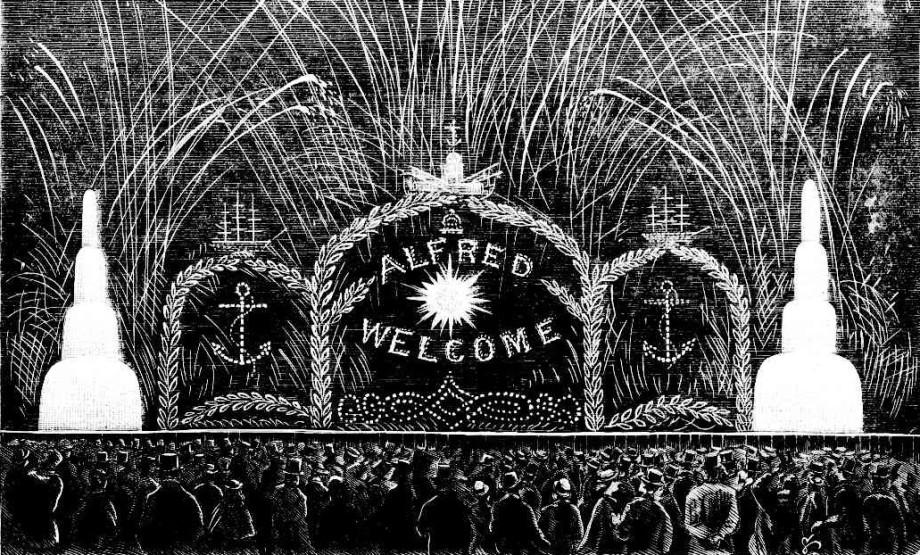
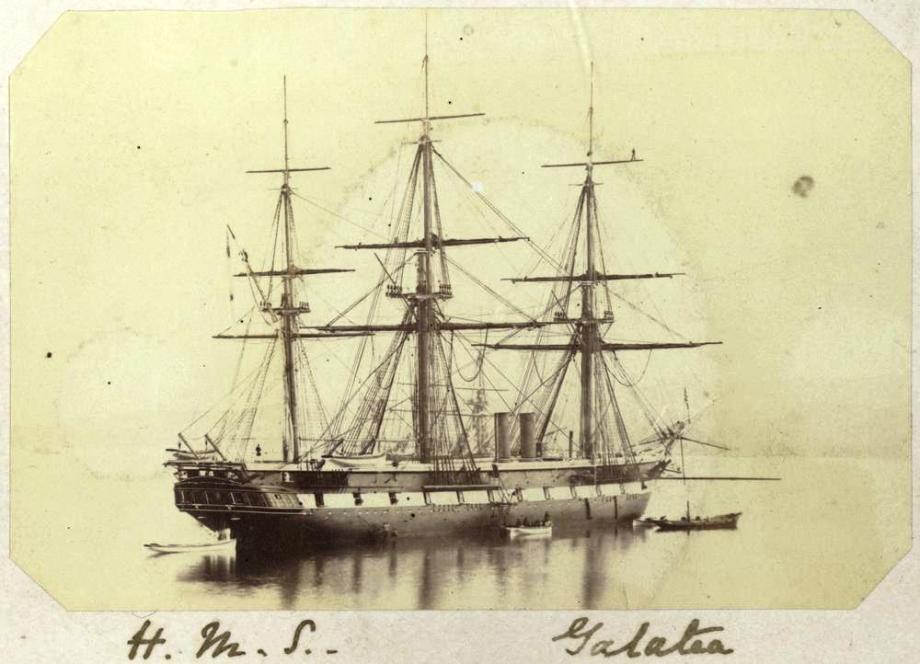
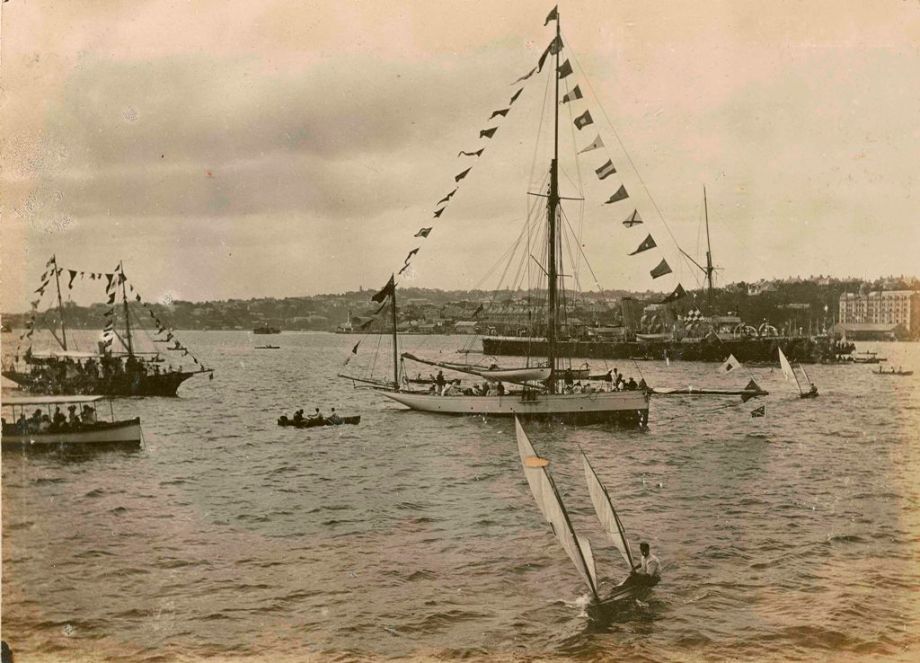
Above: Prince Alfred Yacht Club Regatta - 1895 (?) - Bronzewing and Althea (steamship in background) with yacht. BRONZEWING on the day and was accompanied by the flagship ALATHEA. courtesy ANMM Collection 00019553
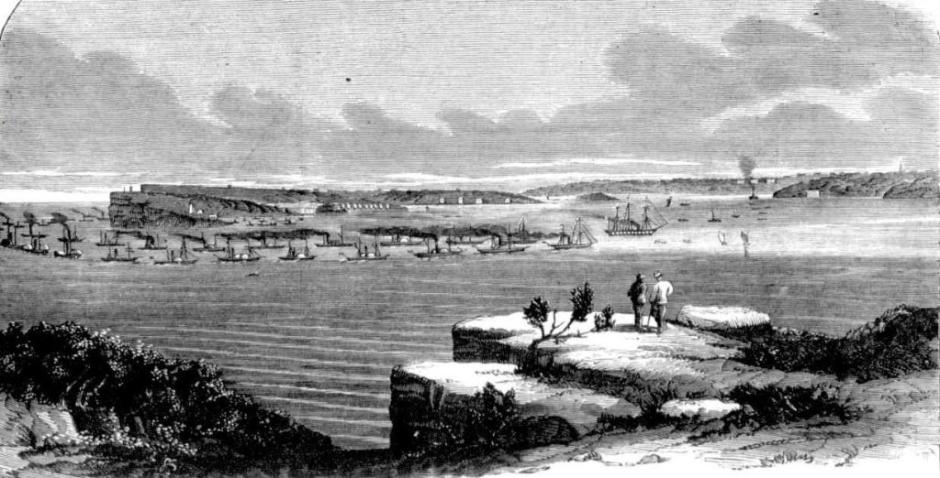
THE GALATEA ENTERING SYDNEY HARBOR.
THE GALATEA ENTERING, SYDNEY HARBOR. (1868, March 3). Illustrated Australian News for Home Readers (Melbourne, Vic. : 1867 - 1875), p. 1 Supplement: SUPPLEMENT TO THE ILLUSTRATED AUSTRALIAN NEWS. Retrieved from http://nla.gov.au/nla.news-article60450599
The First Royal Visitor to Australia: the Incident at Clontarf: March 12th, 1868 - threads collected and collated by A J Guesdon, 2015.